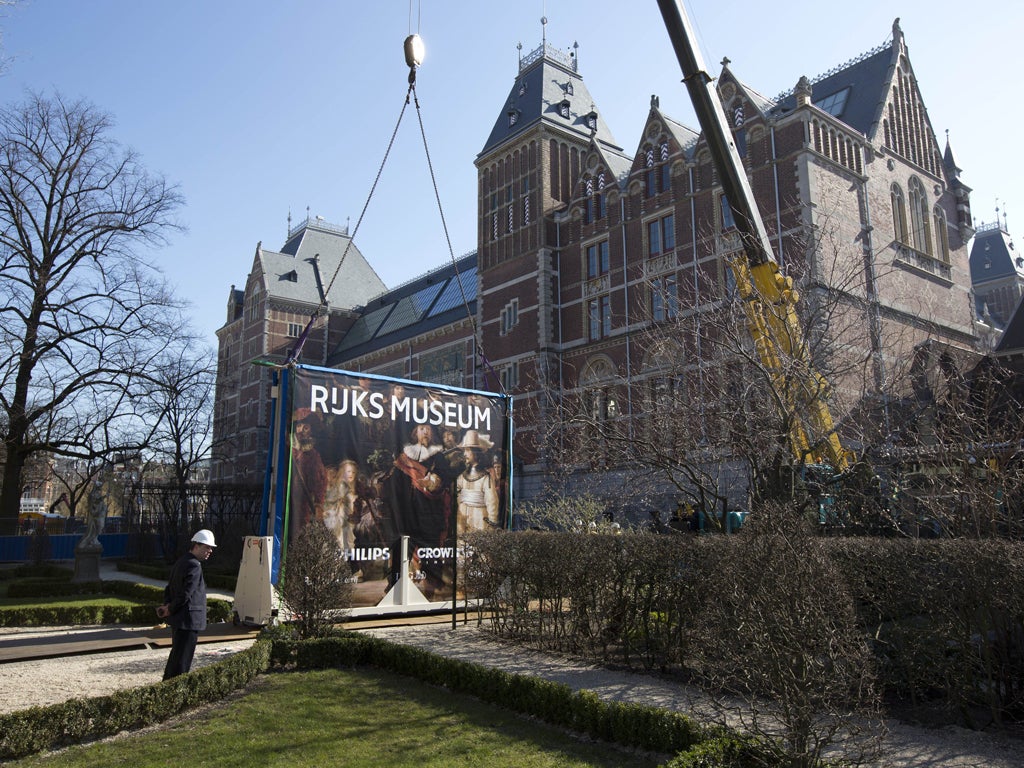The joy of the Rijksmuseum: A museum mustn’t be afraid of being boring
Museums are about more than plunging you into a holistic version of the past

Well, the Rijksmuseum looks simply gorgeous – as well it should, after 10 years out of service and having €375m spent on it.
The building has been restored to its 19th‑century glory, noble-minded frescoes, loony brickwork, St Pancras-like design and all; fashionable architects have done their best to supply the newly indispensable atrium. Cellars have been dug, and, this being the Netherlands, pumped dry several times. The only thing left are the displays, and, handsome as they are, they tell us a lot about how we are choosing to relate to the past.
Back in the day, a museum would categorise its holdings by subject, form and meaning, and place several comparable examples together. Dutch painting, which is at the centre of the Rijksmuseum’s holdings, is peculiarly suitable to this. Painters worked within a number of set genres – there are flower painters, landscape painters, still-life artists, portraitists, painters of farmyard animals and sea battles. In the past, you would have walked into a room to see, for instance, a whole group of church interiors or champion cows. Probably you would glance round and leave, unless you were a particular fan of (in this case) Saenredam or Paulus Potter, in which case you would be in for a long and happy afternoon.
The Rijksmuseum, like most national museums, holds all sorts of things. The curators have decided to restrict the quantity on display – 10 per cent of its entire holdings, I am told – and branch out into variousness. When you walk through the new Rijksmuseum, a room will contain furniture, paintings, ceramics, jewellery, silverware, even clothing – illuminating a moment in time variously. The paintings won’t all be by the same painter, and won’t belong in the same genre. A still life hangs next to a portrait and a flower painting.
It’s not a new approach – our own Wallace Collection has always taken very much the same tack – but it’s a very appropriate one to our age. They aren’t historically accurate interiors; they seek to push you back into a multifarious version of the past – an experience, in short.
I’m in two minds about this. There’s no doubt that the mixture of stunning objects makes for a much more digestible journey than the old-fashioned, solidly unvaried museum experience. But it is hard to see the whole story of an aspect of Dutch art; you glimpse it, and are swept off to something else immediately. Would you know, without prior warning, how important flower painting was to this culture? I’m not sure.
Museums are about more than plunging you into a holistic version of the past. They are, or ought to be, about letting you explore a single, perhaps overlooked facet. Oddly, the things in the new Rijksmuseum I found most rewarding were the moments when it did lapse into old-style concentration on a single fact – a marvellous case of rock-crystal vessels, or five sublime still lifes by Adriaen Coorte in a line. Best of all is the sequence of Rembrandts, including the loan of that greatest of portraits, Jan Six, from the Six collection.
After all, it turns out that you do want to sink into a single fact. A museum doesn’t have to bore you, I feel, but it mustn’t be afraid of being boring. Quite a good rule of intellectual endeavour generally, that one.
Hate crime: surely there’s a limit
Why do people hate goths? It’s a serious question. The blameless and persistent sect, given to blacks and purples and leather, is reliably made up of intelligent and rather sensitive young people. Despite a sometimes alarming outward appearance, they offer no threat to anyone. The worst treatment an ideal world would give them would be to misunderstand them. I have to report that the YouTube film of “Moonchild” by Fields of the Nephilim, a quintessentially pasty goth band, is preceded by a sunscreen advert asking perkily: “What are you like on the beach?” That is called misunderstanding your market with a vengeance.
But they are hated. A goth girl, Sophie Lancaster, was murdered in 2007 for no reason but her tribal affiliations. Her family has campaigned for violence against social groups such as goths to be recognised as hate crimes, like violence against ethnic or sexual minorities, and this week Greater Manchester Police said it was going to start registering such attacks in this way.
We probably have great sympathy for the Lancasters, and for victimised sub-groups. But this is dangerous ground. Might not other minorities start claiming the status of hate crime when they are attacked? The drunken hen party in a gay bar, told to piss off? The public schoolboy, ridiculed on a train? For that matter, a Chelsea supporter finding himself in an Arsenal milieu?
We would very quickly get quite far removed from the original purpose of hate crime – the directing of violence against people because of who they are. Violence against goths is a hateful crime. Is it a hate crime? When you look at the details of Sophie Lancaster’s killing, it is hard to disagree. But this far, and no further. We also might try not detesting strangers because of how they choose to dress, look and speak.
Twitter: @PhilipHensher

Join our commenting forum
Join thought-provoking conversations, follow other Independent readers and see their replies